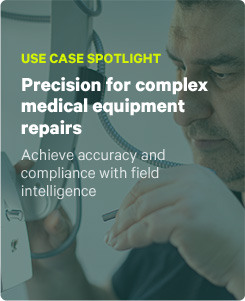In the modern business landscape, many service leaders are searching for ways to streamline operations to increase efficiency amongst a widening skill gap among field engineers. One area where this can be the most difficult, however, is data collection and management.
Fortunately, the use of forms automation technology can provide a solution. By automating data collection and analysis, companies can save time and resources, while also reducing errors and increasing the overall quality of their data.
In this blog, you’ll learn the top four tips for executing automated field service workflows for a more efficient and connected field service organization.
What should I consider when automating field service workflows?
Remember, workflow automation is about more than just replacing paper. After all, the most effective systems can automatically trigger steps and route business intelligence in mere moments, drastically increasing organizational agility. When looking to optimize an existing workflow, here’s what to think about.
How can I open up workflow development and remove IT barriers?
To make a workflow the best it can be, it’s essential to base it on the actual work your field engineers do in the field. After all, who knows your business better? Regrettably, though, this can pose a challenge when the IT department is the only one who owns the development process.
That’s where our platform comes in. It enables non-IT personnel, known as citizen developers, to create forms and processes visually without having to understand complex programming languages. By making workflows and their development more accessible, you can make routine tasks like dispatching, job execution, and work order sign-off faster and easier than ever.
How can I make data collection quicker?
In the world of field service, a workflow is only as good as the data it moves. To ensure the smooth execution of tasks, quick and accurate data collection is paramount.
That’s why speeding up data collection is a surefire way to improve operations. With automation, you can equip all your field engineers with mobile devices and tablets to capture work order items and site evidence and receive real-time instructions back for completing tasks on site. This not only eliminates tedious, time-consuming tasks but also helps reduce human errors.
How can I gather data and transform it into intelligence?
Unfortunately, raw data collected in the field is often fragmented and lacks context. This makes it tremendously difficult to use in a way that really affects the business.
In this area, automated mobile workflows can help by enabling your field teams to collect better data and create powerful links between information. This includes part requests, asset photos, and scheduled service events. By integrating across your customer relationship management (CRM), field service management (FSM), and back-end systems, you can ensure that the resulting information is actionable and touches all aspects of the workflow.
Ultimately, doing this can help break down data silos and provide the rich context you need for the information you collect, leading to improved decision-making and optimized field service operations.
How can I route data effectively?
Enriched data is useful to more than just field engineers; it’s also a game-changer for field service leadership because it grants them a comprehensive view of operations and increases organizational agility.
By using automated field service workflows, you can automatically send information to separate departments in real-time. This includes partners, customers, vendors, back-end systems, and regulatory agencies. You can also customize output as notifications, form submissions, or output documents, depending on who needs it.
For example, The Iron Ore Company of Canada revolutionized their business from a reporting and compliance standpoint by examining their training processes. This led to several benefits, including improved safety standards, the ability to meet training compliance regulations, reduced data entry time, increased job satisfaction for field trainers, and long-term sustainability.
Conclusion
As you have seen, automating field service workflows streamlines data collection and management, which has tremendous effects on efficiency, communication, and safety. It’s not surprising why so many of our customers see benefits like improved administrative productivity, increased engineer productivity, and reduced compliance fines after implementation.
Ready to optimize? Book a demo and see how we can help you can simplify routine tasks, eliminate errors, and provide enriched data for better field service organization today.



